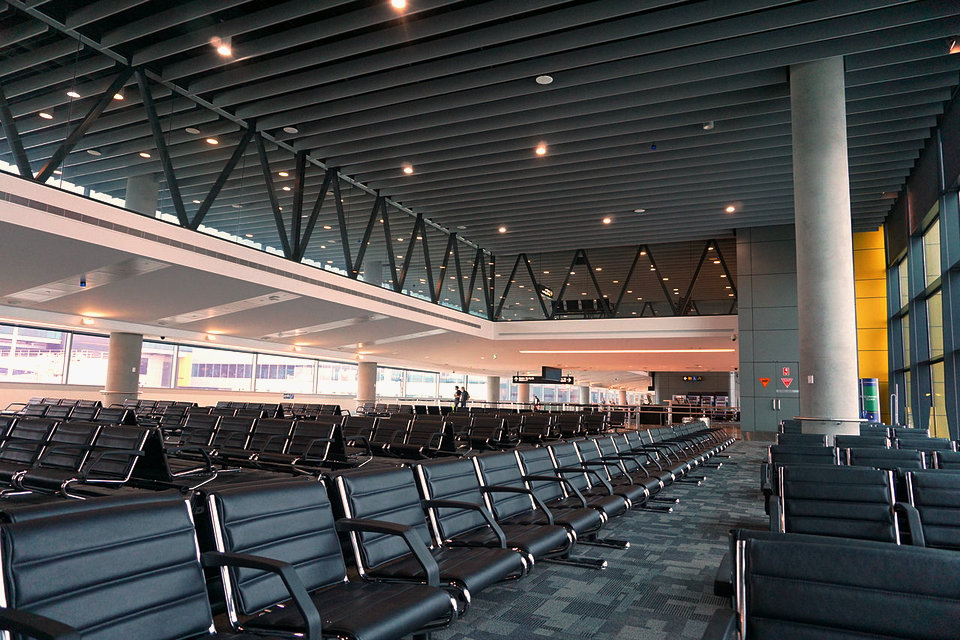Low cost carrier terminal


Low cost carrier terminal or LCCT a.k.a. budget terminal is a specific type of airport terminal designed with the needs of low cost airlines in mind. Though terminals may have differing charges and costs, as is common in Europe, the concept of an all budget terminal was promoted and pioneered by Tony Fernandes of AirAsia at Kuala Lumpur International Airport in 2006.
Description
In some cases, the designs of a low cost carrier terminal mimic old designs of an airport terminal, such as the former airport of Hong Kong, Kai Tak Airport. With a stripped-down airport terminal, airports can reduce daily operating costs significantly, thereby passing along the savings to budget airlines and ultimately their passengers. It specifically entails cost reductions from normal airports in terms of:
Physical building:
forgoing expensive architectural design for simple boxy warehouse-like design.
low ceilings.
foregoing steel and glass structures to reduce air conditioning overhead cost.
Amenities:
may have less choice in terms of restaurants and duty-free shops.
decoration may be mostly airline ads.
Support structures:
long corridors, moving walkways, and jet bridges often replaced by transport with airport buses and boarding with airstairs. (This also allows quicker plane turnaround time, which may lower landing fee, and increase aircraft utilization).
Baggage handling is much simplified, e.g. some LCCTS lack Baggage carousels.
However these terminals may also have modern facilities such as free Wi-Fi, and be comfortably air conditioned. A German study (Swanson 2007) of costs showed that at Malaysia’s KLIA and Changi LCCTs, airlines were charged roughly 2/3 to 3/4 the total cost of landing at the main terminal; for budget-sensitive carriers, any savings advantage can be critical.
Klia2 billed as the world’s largest purpose-built terminal dedicated to low-cost carriers, is designed to cater for 45 million passengers a year with future capacity expansion capability. Built at a cost of US$1.3 billion, klia2 started commercial operations on May 2, 2014 at the Kuala Lumpur International Airport (KLIA) in Malaysia.
Realisation of the projects
While the concept of a simple basic terminal in theory would lower costs, in practice, it can be turned into a pork barrel project such as klia2.
When klia2 was first proposed MAHB said it would cost MYR2 billion, a figure that was later revised to MYR2.6 billion. Then came news that the terminal would cost MYR4 billion, double the original estimate. Now there’s talk that the bill could go as high as MYR5 billion. That makes no sense – the low-cost terminal will now cost much more than KLIA. Yes, I asked for a new terminal but one that has simple facilities. Did it have to cost 20 times our present LCCT?
— Tony Fernandes, on klia2.
Budget terminals also have to consider if they only serve budget airlines or all airlines. In this way, a terminal can essentially “lose its budget identity”. In the case of Macau airport, “from an airport perspective, having a separate LCCT is frequently more expensive than having one terminal for all carrier types because of the need to duplicate services and systems including check-in, security and immigration.” In the case of KLIA2, Malaysia Airports has instructed Airasia in 2016 that the overbudget terminal isn’t a LCCT terminal at all.
List of existing/expanding budget terminals
Australia Melbourne Airport – the first budget terminal in Australia, Terminal 4 is currently used by Tiger Airways Australia and Jetstar Airways.
France Marseille Provence Airport – first terminal entirely developed for low cost airlines in France.
France Lyon-Saint Exupéry Airport – the creation of Terminal 3, a former charter facility for low cost airlines.
Hungary Budapest International Airport – not a dedicated low cost terminal though Terminal 2 is cheaper to use than Terminal 1.
India Indira Gandhi International Airport – Terminal 1 not dedicated to but being used by Low-Cost carriers
India Chhatrapati Shivaji International Airport – Terminal 1 not dedicated to but being used by Low-Cost carriers (domestic flights only)
Indonesia Soekarno-Hatta International Airport – Terminal 3 (old), will replaced with Terminal 3 Ultimate, all LCC airlines will moves to terminal 1 or 2.
Israel Ben Gurion International Airport – Terminal 1, Dedicated for Low-Cost international flights, opened at June 2017
Italy Rome Fiumicino Airport – Terminal 2 is exclusively dedicated to low-cost carriers.
Japan Naha International Airport – small budget terminal opened Oct 2012.
Japan Narita International Airport Terminal 3 opened April 8, 2015 with discounted airport tax.
Japan Kansai International Airport – small budget terminal opened Oct 2012.
Georgia (country) David the Builder Kutaisi International Airport – airport served mainly by low cost carriers
Malaysia Kuala Lumpur International Airport – klia2, opened at May 2014 and is a hybrid terminal that accommodates low cost carrier.
Malaysia Kota Kinabalu International Airport – not a true LCCT terminal as non-budget carriers use this terminal, but incorporates the concept.
Poland Warsaw-Modlin Mazovia Airport – airport dedicated to low cost carriers.
Singapore Changi International Airport – old budget terminal demolished for new with 7 million passenger capacity.
List of proposed budget terminals
Taiwan Taoyuan International Airport
Philippines Clark International Airport
Russia Ramenskoye Airport
Thailand Bangkok is also urged by airlines to consider such a terminal
Japan Chubu (Nagoya) was considering it in 2013.
Australia Brisbane is considering a LCCT under its master plan.
Philippines Transportation Secretary of Philippines unveiled a plan for a LCCT at NAIA.
China is actively looking into LCCTs as well as low cost carriers.
Source from Wikipedia